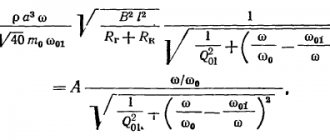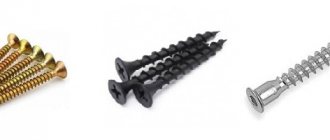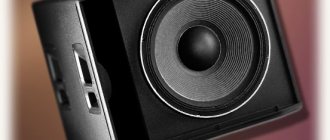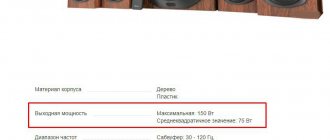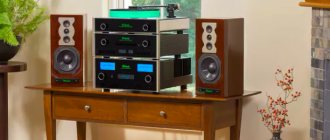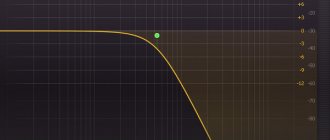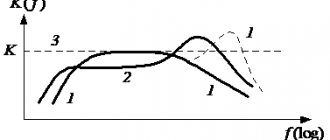The abundance of speakers with different characteristics for the low-frequency section (or rather, the subwoofer) can plunge a person trying to build sound in an acoustic system into a state of confusion. And I hope this help helps someone.
It may seem strange, but the speaker is mainly characterized by three main Thiel-Small parameters:
- Fs is the resonance frequency in open space;
- Qts - total quality factor of the speaker; And
- Vas is the equivalent volume.
I think everyone understands what Fs means, but what are Qts and Vas? The answer is: Qts (true for the acoustic design of an infinite screen and a closed box) is the ratio of the transfer function of the speaker at frequency Fs to the transfer function at frequencies where the amplitude-frequency response (AFC) of the speaker is horizontal, i.e. at frequencies above Fs. In other words, Qts characterizes the efficiency of the speaker at the resonant frequency. Thus, if Qts = 0.707, then at Fs the value of the sound pressure created by the speaker will be less than at the horizontal section of the frequency response by 20*Log10(0.707)=-31 dB, if Qts = 0.3 - then by -10.5 dB.
Vas is the volume of air that has the same flexibility (the inverse of elasticity) as the moving speaker system.
When a speaker is placed in a closed box (CC), the flexibility of the air inside the box adds to the flexibility of the speaker's moving system and its resonant frequency changes. There is the following pattern: when a speaker is placed in a box of volume Vas, its resonant frequency Fs and quality factor Qts increase by 1.4 times.
Armed with this information, let's select speakers for a hypothetical car whose interior transfer function has a rise of 12 dB/octave, starting at 55 Hz towards low frequencies. Trunk volume is 300 liters. Well, let a 30 liter subwoofer box fit into the trunk of our car painlessly for the owner. We will select speakers for the three (most common) types of acoustic design, namely:
- infinite screen (EB), V is much larger than Vas;
- closed box (CL), V comparable to Vas;
- bass reflex (FI), V is comparable to Vas.
All systems must have F3 (the frequency at which the system’s frequency response is 3 dB lower than in the horizontal section and continues to fall towards low frequencies) equal to 55 Hz and Qt = 0.707 (the total quality factor of the system, at which the most even frequency response is achieved) .
So, you need F3=55Hz and Qts=0.707, frequency response roll-off -12 dB/octave.
Bass reflex
The most interesting. I’ll say right away that the bass reflex is a tricky thing. For FI, a smooth frequency response is obtained with different combinations of parameters Vas/V, Fs/F3 and Qts. Therefore, for rough estimates, you will have to make a (fairly correct) assumption: when using a speaker with Qts = 0.3...0.5, for the optimally calculated FI Vas/V = 1.4. For such a FI the following relations are valid:
F3=Fs*(Vas/V)^0.44;
Vas/V=1/(20*Qts^3.3).
For our case we get: Fs= 47.4 Hz, Qts= 0.36, Vas=V*1.4=30*1.4=42 liters, the FI frequency response below F3 has a decline of -24 dB/octave.
The results are summarized in a table for clarity.
| Decor | BE | ZY | FI |
| Fs | 55 | 39,3 | 47,4 |
| Qts | 0,707 | 0,505 | 0,36 |
| Vas | up to 30 l | 30 | 42 |
| Frequency response slope | -12 db/octave | -12 db/octave | -24 db/octave |
It can be seen that the speakers are different and in no way interchangeable. The above rough calculations can be used to select a speaker for a specific design.
In search of a closed box or why an entire class of speaker systems is disappearing
The global audio industry is growing rapidly. The vector of this development is known, the ability to produce convenient electronics at minimal cost. It would seem that one of the most logical types of acoustic design, which does not require anything other than precise calculations, is the most technologically advanced and cheapest, is a closed box (CH). With this design, it is possible to minimize cabinet resonances, obtain a relatively flat frequency response, and, with adequate damping, prevent the appearance of standing waves noticeable to the ear. It turns out cheap and cheerful, which means it would seem to be in demand. Meanwhile, if you try to find such acoustics among the current offers of online stores and electronics stores, you will be disappointed.
The assortment is extremely small when compared with bass reflex acoustics, while the cost of a closed box is significantly higher. Many will certainly be satisfied with the good old YAMAHA NS-6490 or professional monitors from Behringer. There is also a narrow segment of built-in and landscape acoustics, which are quite niche and rare expensive samples costing half a million, such as the Graham Audio LS5/9f. But in comparison with other types of registration, the percentage of notices is negligible. This means that today, new speakers with closed acoustic design are extremely reluctant to be produced. Below the cut I analyze the situation and discuss why closed boxes are no longer in demand.
Closed drawer niche
From a marketing point of view, the target audience of the closed box is the demanding middle class with an above-average intelligence level.
On the one hand, these are people who well understand the problems of the bass reflex type that has become ubiquitous. On the other hand, these are those who are not able to pay for expensive labyrinth systems and therefore choose a more technologically advanced and inexpensive solution. These are often engineers and other people familiar with the basics of acoustics. In some cases, the same solution may appeal to poor audiophiles who are obsessed with the idea of the highest possible fidelity of reproduction, but do not have enough money for the ultimate, uncompromising and equally irrational expensive solutions from the High End marketing class.
We can say that this category of buyers suffers more than others today from the lack of products. As a rule, they use equipment from the simpler segment, while, on the one hand, they are dissatisfied with its quality, and on the other, when moving to the premium segment, they begin to complain about the cost.
And it would seem that everything is not so complicated, it is enough to start producing well-designed closed boxes from MDF or plywood, and everyone will be happy. But as usual, the devil is in the details.
Dimensions problem
I examined the opinions of 60 people who could be classified into the category I have described.
It turned out that the majority (57 people) of them were very interested in the benefits that a closed box provides. Three said that it was impressive, but they would not be ready to quickly change the acoustics, because... they are quite happy with what they have at the moment. However, when the positive majority learned that to achieve the sound pressure that a bass reflex can usually provide, you would need to increase the volume by 3 times, 38 people abandoned this decision without discussing the benefits and weighing the facts. The rest, loyal to such a constructive solution, have lost their unequivocal confidence that this is better. It turns out that even a solution that fully satisfies the combination of fidelity/cost, having significantly larger dimensions with equal or lower efficiency, ceases to be interesting for the vast majority of potential visitors.
There are 3 reasons for this dislike of sizes. The first is aesthetic; speakers of this size are difficult to combine with a modern interior, where columnar speakers have become the norm over the last 15 years. The second is pragmatic, the AS ZYA eats up the volume of the premises, which you often want to save. The third problem is weight, large dimensions are guaranteed to increase the weight of the device, which creates difficulties in the future, for example, when moving or rearranging.
“Weak bottom”, as the argument of the majority
Those who have heard closed boxes in the form factor of a full-fledged speaker unanimously declare that they have supposedly “weak” low frequencies, which are sorely lacking.
I can’t argue with bass lovers, at least due to the fact that perception is very individual and there is no standard regarding timbre accents. At the same time, the fairly flat frequency response of a closed box does not emphasize the low frequencies, and lovers of “juicy bass” really miss it there. It's statements like these that create the problem in productivity. In fact, by modern standards, the size of such a speaker is disproportionate to the expected sound power of the device. It is too quiet, which makes it much more difficult to visually assess the maximum volume. The eternal thing works: “if they are so big, why are they so quiet, because the neighbor has 2 columns, and he just blows away from them.” And it is precisely for the sake of competition with neighbor Vasya that seemingly intelligent people who are able to appreciate the advantages of the design completely lose the desire to purchase “quiet speakers”.
Subwoofer as an exception
The only modern devices among which you can find PLs in a wide range and price range are subwoofers. The fact is that those who are well versed in physics are quite aware of the psychoacoustic effect, where the human ear is virtually unable to localize low frequency sources (below 80 Hz). At the same time, the ZY has a lot of advantages specifically in terms of low-frequency reproduction, such as a decrease in the probability of resonances, the absence of specific PH overtones, turbulent flows and, due to this, a very smooth frequency response. In this regard, SFs have become in demand specifically for the creation of subwoofers. By the way, compared to nuclear weapons and those using passive emitters, they are also not quite loud.
Dry residue
Let's be honest, despite the big words in the missions of the campaigns, they are all created as a source of income, and accordingly, they care about the notorious “fidelity of reproduction” exactly as much as consumers in their market segment demand.
And, if we look at the marketing appeal of excellent-sounding, but large closed boxes, we see the obvious unprofitability of their revival in the form factor of a full-fledged speaker. Audiophiles and demanding rich people are spoiled by more sophisticated solutions, and the middle class is not ready to sacrifice the space of small apartments. The best solution with 3D design today are subwoofers. If you have a custom crossover, you can adjust the cutoff frequency so that the resonant frequency of the FI stereo pair is reproduced by the sub, and thus obtain the desired smooth frequency response. Also, judging by the products presented on the market, central channel acoustics with a closed acoustic design are popular.
Advertising We sell speaker systems. There are many of them in our catalog; if you wish, you can find closed-type speakers and subwoofers; speakers with a bass reflex are in abundance.
Each band has its own speaker and acoustic design option
Don't forget that in the case of a full-range speaker, it will need one of its own cabinets with carefully calculated characteristics. But if we are dealing with a two- or more-band system, then the emitter of each frequency band must receive its own separate acoustic design.
There were different views on the maximum required number of frequency bands in acoustics. In some samples of speakers from the seventies of the last century, for example, there could be up to 5–7 such stripes. Now we seem to have arrived at the optimal number of bands for full-size speaker systems - from two to four. Bookshelf and budget floor-standing systems often have two bands, and more serious models may, in addition to three bands, have a high-frequency emitter, which is called a super tweeter.
Some developers pay a lot of attention to the shape of the driver cameras
Most often, a full-size floor-standing speaker has three bands, and then almost the entire volume of the cabinet is given over to the acoustic design of the woofer/s. The midrange driver has its own box inside the speaker cabinet, which completely isolates the rear side of the speaker cone from the influence of the woofer. As for the tweeter, the back side of the membrane works on a small volume formed by the design of the speaker itself, or on specially formed additional cavities, for example, in the form of a tube.
At the front, the tweeter most often has a horn design option, which lately is often called a waveguide. This is a wide-opening horn, designed in such a way that the tweeter's directivity pattern matches all other emitters, forming the correct listening area, that is, the area in which the sound of our speaker will be of the highest quality.
How is the office arranged?
The simplest speaker body - also called a cabinet - is an ordinary box. But don’t think that everything is so simple here. The walls of the housing are subject to serious pressure caused by the movement of the diffuser, so the housing must be sufficiently “hard, but not loud,” that is, have good resistance to the occurrence of its own resonances. To do this, additional stiffening elements are installed inside the body - ribs, spacers. The internal volume of the case should ideally not have parallel walls: often they are simply rounded, but completely spherical cases are not that uncommon.
Typical MDF enclosure
It would seem logical to make the walls of the body from ordinary wood, but in this case problems arise associated with heterogeneity (anisotropy) and poor repeatability of the parameters of this material. Therefore, the most common cabinet material has become MDF - wood-fiber board. Birch plywood is also often used, layers of wood veneer are used, sequentially applied to glue, composite materials such as fiberglass, metals - extruded aluminum, steel and even lead.
Concrete columns
Quite successful speakers molded from concrete have appeared at several exhibitions recently. Acoustic cabinet technologies depend on the conditions under which the acoustics will operate. Naturally, for landscape, marine, and automotive systems, materials that are resistant to weather conditions, solar radiation, water, dust, etc. are used.
Resonance frequency
The speaker, as we found out, is an oscillatory system. Left to its own devices, its diffuser oscillates at a certain frequency when exposed. That is, it behaves in approximately the same way as a string after plucking or, for example, a bell after being struck.
It is believed that the resonant frequency can be:
- for subwoofer heads not installed in the housing - 20-50 Hz;
- midbass speakers - 50-120 Hz;
- tweeters - 1000-2000 Hz;
- diffuser midrange drivers - 100-200 Hz;
- dome - 400-800 Hz.
You can measure the resonant frequency of a speaker, for example, by passing a sound generator signal through it (by connecting a resistor in series with it) or by any other similar methods. This indicator is determined by the peak impedance of the device.
What else does it depend on?
Design thus has a great influence on the quality factor of the speaker. Also, this indicator for such equipment depends on:
- The power of its engine. The higher this characteristic, the lower the quality factor of the head.
- Movement masses. As this indicator increases, the motor forces in the sound transmitting device become less noticeable. At the same time, friction losses increase. As a result of all this, the quality factor of the device increases.
- Diameter of wires. If the wires in the speaker provide high resistance, the electrical quality factor of the device will increase. Indeed, in this case, the load on the speaker, which is a kind of generator, drops.
First difficulties
The first (and main) difficulty is this: if a relatively small-volume box needs to be tuned to a fairly low frequency, then by substituting a large diameter into the formula for the length of the tunnel, we will get a larger length. Let's try to substitute a smaller diameter - and everything works out fine. A large diameter requires a long length, and a small one requires just a short length. What's wrong with that? Here's what.
While moving, the rear side of the speaker diffuser “pushes” practically incompressible air through the bass reflex tunnel. Since the volume of oscillating air is constant, the air speed in the tunnel will be as many times greater than the oscillatory speed of the diffuser, how many times the cross-sectional area of the tunnel is less than the area of the diffuser. If you make a tunnel tens of times smaller than the diffuser, the flow speed in it will be high, and when it reaches 25–27 meters per second, turbulence and jet noise will inevitably appear.
The great researcher of acoustic systems R. Small showed that the minimum cross-section of the tunnel depends on the diameter of the speaker, the maximum stroke of its diffuser and the tuning frequency of the bass reflex. Small proposed a completely empirical, but trouble-free formula for calculating the minimum tunnel size:
Small derived his formula in his usual units, so that the speaker diameter Ds, the maximum cone stroke Xmax and the minimum tunnel diameter Dmin are expressed in inches. The bass reflex tuning frequency is, as usual, in hertz.
Now things don't look as rosy as before. It often turns out that if you choose the right tunnel diameter, it turns out to be incredibly long. And if you reduce the diameter, there is a chance that the tunnel will “whistle” even at medium power. In addition to the jet noise itself, small-diameter tunnels also have a tendency to so-called “organ resonances,” the frequency of which is much higher than the bass reflex tuning frequency and which are excited in the tunnel by turbulence at high flow rates.
When faced with such a dilemma, ACS readers usually call the editor and ask for a solution. I have three of them: simple, medium and extreme.
What is the characteristic
So, speaker quality factor - what is this indicator? Focusing on this characteristic, you can first of all determine how the oscillatory movements of sound emitters are damped. It is believed that this indicator for the heads should not be too high.
If the Q value of a speaker is high and equal to, for example, 2 or 3, then the oscillations in it will continue even after the force that caused them disappears. This will, of course, reduce the sound quality. Sound effects that irritate the ear will begin to appear in the speakers.
With a low quality factor (less than 1), the oscillations in the device die out very quickly. That is, in dynamics, after a sharp impact, the membrane almost immediately comes to a stable state. As a result, the device produces clearer and more pleasant sound. Accordingly, experts rarely think about how to increase the quality factor of a speaker. Basically, when designing acoustic systems, craftsmen try to make this figure lower.
Horn
All of the above acoustic design options are used, for the most part, in the low frequency region. As for the remaining frequencies of the audible range, horn acoustic design options are applicable here. In fact, horns are also made for low frequencies, but they turn out to be very large.
This is how a megaphone works
The horn allows you to make the study of the speaker narrowly focused, sharply raising the sound pressure, that is, the volume, in the listening area. Nowadays, horn systems are used infrequently. On the one hand, their sound can be called audiophile. On the other hand, horn systems are characterized by serious uneven amplitude-frequency characteristics - such speakers are very good for some genres of music and not suitable for others.
Simple solution for small problems
When the calculated length of the tunnel is such that it almost fits in the housing and only a slight reduction in its length is required with the same setting and cross-sectional area, I recommend using a slotted tunnel instead of a round one, and placing it not in the middle of the front wall of the housing (as in Fig. 6 ), but close to one of the side walls (as in Fig. 7).
Figure 6. Slot tunnel located far from the walls of the box.
Then at the end of the tunnel, located inside the box, the effect of “virtual lengthening” will be affected due to the wall located next to it. Experiments show that, with a constant cross-sectional area and tuning frequency, the tunnel shown in Fig. 7, turns out to be approximately 15% shorter than with the design as in Fig. 6.
Figure 7. Slot tunnel located near the wall. As a result of the influence of the wall, its “acoustic” length turns out to be longer than the geometric one.
A slotted bass reflex, in principle, is less prone to organ resonances than a round one, but to protect yourself even more, I recommend installing sound-absorbing elements inside the tunnel, in the form of narrow strips of felt, glued to the inner surface of the tunnel in the region of a third of its length. This is a simple solution. If it is not enough, you will have to go to the middle one.


